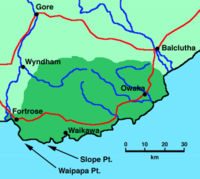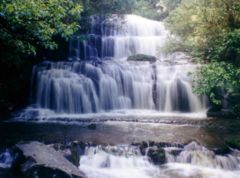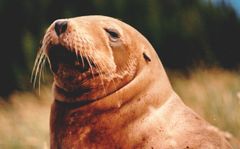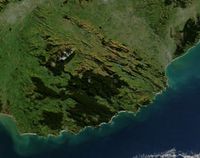The Catlins
2008/9 Schools Wikipedia Selection. Related subjects: Geography of Oceania (Australasia)
|
|
|
 |
|
|
|
|
| Location | |
|---|---|
| Country: | New Zealand |
| Island: | South Island |
| Statistics | |
| Population: | approximately 1,200 (2001) |
| Area: | 1,900 km² / 730 sq mi |
| Location | |
| Latitude: | 46° 30' S |
| Longitude: | 169° 30' E |
| Administration | |
| Regions: | Otago and Southland |
| Districts: | Clutha District and Southland District |
| Main towns and settlements: | Owaka, Waikawa, Kaka Point, Fortrose |
| Parliamentary electorate: | Clutha-Southland |
The Catlins (sometimes referred to as The Catlins Coast) comprises an area in the southeastern corner of the South Island of New Zealand. The area is between Balclutha and Invercargill, and is in both the Otago and Southland regions. It includes the South Island's southernmost point, Slope Point.
The Catlins, a rugged, sparsely populated area, features a scenic coastal landscape and dense temperate rainforest, both of which are home to many endangered species of birds. Its exposed location leads to its frequently wild weather and heavy ocean swells, which are an attraction to big-wave surfers.
Ecotourism has become of growing importance in the Catlins economy, which otherwise relies heavily on dairy farming and fishing. The region's early whaling and forestry industries have long since died away, along with the coastal shipping that led to several tragic shipwrecks. Only some 1,200 people now live in the area, many of them in the settlement of Owaka.
Geography
The Catlins area covers some 1900 km² (730 sq mi) and forms a rough triangular shape, extending up to 50 km (30 mi) inland and along a stretch of coast 90 km (60 mi) in extent. It is bounded to the northeast and west by the mouths of two large rivers, the Clutha River in the northeast and the Mataura River in the west. To the north and northwest, the rough bush-clad hills give way to rolling pastoral countryside drained and softened by the actions of tributaries of these two rivers such as the Pomahaka River.
The Catlins boasts a rugged, scenic coastline. Natural features include sandy beaches, blowholes, a petrified forest at Curio Bay, and the Cathedral Caves, which visitors can reach at low tide. Much of the coastline is high cliff, with several faces over 150 m (500 ft) in height, and the land rises sharply from the coast at most points. For this reason, many of the area's rivers cascade over waterfalls as they approach the ocean (notably the iconic Purakaunui Falls on the short Purakaunui River).
The South Island's southernmost point, Slope Point, projects near the southwestern corner of the Catlins. To the west of this lies Waipapa Point, often considered the boundary of the Catlins region, beyond which lies the swampy land around the mouth of the Mataura River at the eastern end of Toetoes Bay. The western boundary of the Catlins region is not well-defined, however, and some more stringent definitions exclude even Slope Point.
Several parallel hill ranges dominate the interior of the Catlins, separated by the valleys of the Owaka, Catlins and Tahakopa Rivers, which all drain southeastwards into the Pacific Ocean. The most notable of these ranges is the Maclennan Range. Between them, these hills are often simply referred to as the Catlins Ranges. Their northwestern slopes are drained by several tributaries of the Clutha and Mataura Rivers, most notably the Mokoreta River, which flows mainly westwards, reaching the Mataura close to the town of Wyndham.
The highest point in the Catlins, Mount Pye — 720 m (2361 ft) — stands 25 km (15 mi) north-northeast of Waikawa and close to the source of the Mokoreta River, and marks part of the Otago-Southland border. Other prominent peaks above 600 m (2000 ft) include Mount Rosebery, Catlins Cone, Mount Tautuku, and Ajax Hill.
The Catlins has several small lakes, notably scenic Lake Wilkie close to the Tautuku Peninsula. Catlins Lake, near Owaka, is actually the tidal estuary of the Catlins River.
Shipping has found the Catlins coast notoriously dangerous, and there have been many shipwrecks on the headlands that jut into the Pacific Ocean here. Two lighthouses stand at opposite ends of the Catlins to help prevent further mishaps. The Nugget Point lighthouse stands 76 m (250 ft) above the water at the end of Nugget Point, casting its light across a series of eroded stacks (the "nuggets" which give the point its name). It was built in 1869–70. The Waipapa Point light, which stands only 21 m (70 ft) above sea level, was the last wooden lighthouse to be built in New Zealand, and was constructed in 1884 in response to the tragic 1881 wreck of the Tararua. Both of these lighthouses are now fully automated.
Due to its position at the southern tip of New Zealand, the Catlins coastline lies exposed to some of the country's largest ocean swells, often over 5 m (16 ft). Big wave surfing is developing into a regional attraction, with regular competitions and feats like Dunedin surfer Doug Young's award-winning 11 m (36 ft) wave in 2003 gathering publicity for the sport.
Climate
The Catlins has a cool maritime temperate climate, somewhat cooler than other parts of the South Island, and strongly modified by the effect of the Pacific Ocean. Winds can be strong, especially on the exposed coast; most of the South Island's storms develop to the south or southwest of the island, and thus the Catlins catches the brunt of many of these weather patterns.
The Catlins — and especially its central and southern areas — experiences considerably higher precipitation than most of the South Island's east coast; heavy rain is infrequent, but drizzle is common and 200 days of rain in a year is not unusual. Rain days are spread fairly evenly throughout the year; there is no particularly rainy season in the northern Catlins, and only a slight tendency towards more autumn rain in the southwest. The average annual rainfall recorded at the Tautuku Outdoor Education Centre is about 1,300 mm (51 in), with little variation from year to year.
Fine days can be sunny and warm, and daily maxima may exceed 30 °C (86 °F) in mid summer (January-February). A more usual daily maximum in summer would be 18–20 °C (64–68 °F). Snow is rare except on the peaks even in the coldest part of winter, though frost is quite common during the months of June to September. Typical daily maximum temperatures in winter are 10–13 °C (50–55 °F).
History
The first people known to live in the Catlins , Māori of the Kāti Mamoe, Waitaha, and Kāi Tahu iwi, merged via marriage and conquest into the iwi now known as Kāi Tahu. Archaeological evidence of human presence dates back to AD 1000. The area's inhabitants were semi-nomadic, travelling from Stewart Island/Rakiura in the south and inland to Central Otago. They generally dwelt near river mouths for easy access to the best food resources. In legend, the Catlins forests further inland were inhabited by Maeroero (wild giants).
The Catlins offered one of the last places where the giant flightless bird, the moa, could be readily hunted, and the timber of the forest was ideal for canoe construction (the name of the settlement Owaka means "Place of the canoe"). No formal Māori pa were located in the Catlins, but there were many hunting camps, notably at Papatowai, near the mouth of the Tahakopa River.
Europeans first sighted the area in 1770 when the crew of James Cook's Endeavour sailed along the coast. Cook named a bay in the Catlins area Molineux's Harbour after his ship's master Robert Molineux. Although this was almost certainly the mouth of the Waikawa River, the name was later applied to a bay to the northeast, close to the mouth of the Clutha River, which itself was for many years known as the Molyneux River.
Sealers and whalers founded the first European settlements in the early years of the 19th century, at which time the hunting of marine mammals was the principal economic activity in New Zealand. A whaling station was established on the Tautuku Peninsula in 1839, with smaller stations at Waikawa and close to the mouth of the Clutha River.
The Catlins take their name from the Catlins River, itself named for Captain Edward Cattlin (sometimes spelt Catlin), a whaler who purchased an extensive block of land along Catlins River on February 15, 1840 from Kāi Tahu chief Hone Tuhawaiki (also known as "Bloody Jack") for muskets and £30 (roughly NZ$3000 in 2005 dollars). New Zealand's land commissioners declined to endorse the purchase and much of the land was returned to the Māori after long negotiations ending over a decade after Cattlin's death.
During the mid-19th century the area developed into a major saw-milling region, shipping much of the resultant timber north to the newly-developing town of Dunedin from the ports of Waikawa and Fortrose. A 200 ft (60 m) long jetty was built at Fortrose in 1875, although this has long since disappeared.
Several shipwrecks occurred along the treacherous coastline during this period. Most notably, one of New Zealand's worst shipping disasters occurred here: the wreck of the passenger-steamer Tararua, en-route from Bluff to Port Chalmers, which foundered off Waipapa Point on April 29, 1881 with the loss of all but 20 of the 151 people aboard.
Another noted shipwreck, that of the Surat, occurred on New Year's Day in 1874. This ship, holed on rocks near Chasland's Mistake eight kilometres southeast of Tautuku Peninsula, limped as far as the mouth of the Catlins River before orders were given to abandon ship. A beach at the mouth of the Catlins River is named Surat Bay in commemoration of this wreck. The schooner Wallace and steamer Otago were also both wrecked at or near Chasland's Mistake, in 1866 and 1876 respectively, and a 4600 tonne steamer, the Manuka, ran aground at Long Point north of Tautuku in 1929.
From the time of the Great Depression until the formation of the New Zealand Rabbit Board in 1954, rabbits became a major pest in the area, and rabbiters were employed to keep the creatures under control. The trapping of rabbits and auctioning of their skins in Dunedin became a minor but important part of the Catlins area's economy during this time.
After a decline in the 1890s, the logging of native timber expanded into new areas made accessible by an extension of the railway, before petering out in the mid-20th century. One nail in the industry's coffin came with a series of bush fires which destroyed several mills in 1935. Much of the remaining forest is now protected by the New Zealand Department of Conservation as part of the Catlins Forest Park.
Natural history
Wildlife
The Catlins coast often hosts New Zealand Fur Seals and Hooker's Sea Lions, and Southern Elephant Seals can occasionally be seen. Several species of penguin also nest along the coast, notably the rare Yellow-eyed Penguin (Hoiho), as do mollymawks and Australasian Gannets, and the estuaries of the rivers are home to herons, stilts, godwits and oystercatchers. Bitterns and the threatened Fernbird (Matata) can also occasionally be seen along the reedy riverbanks.
In the forests, endangered birds such as the yellowhead (mohua) and kakariki (New Zealand parakeet) occur, as do other birds such as the tui, fantail (piwakawaka), and kererū (New Zealand pigeon). One of New Zealand's only two species of non-marine mammal, the Long-tailed Bat, is found in small numbers within the forests, and several species of lizard are also found locally, the most populous of which is the Common Gecko.
Many species of fish, shellfish, and crustaceans frequent both the local rivers and sea, notably crayfish and paua. Nugget Point in the northern Catlins is host to a particularly rich variety of marine wildlife. The proposed establishment of a marine reserve off the coast here has, however, proved controversial. Hector's Dolphins can often be seen close to the Catlins coast, especially at Porpoise Bay near Waikawa.
Flora
The Catlins features dense temperate rainforest, dominated by podocarps (which covers some 600 km² or 230 sq mi of the Catlins). The forest is thick with trees such as Rimu, Totara, Silver Beech, Matai and Kahikatea. Of particular note are the virgin Rimu and Totara forest remaining in those areas which were too rugged or steep to have been milled by early settlers, and an extensive area of Silver Beech forest close to the Takahopa River. This is New Zealand's most southerly expanse of Beech forest. Many native species of forest plant can be found in the undergrowth of the Catlins forest, including young Lancewoods, orchids such as the Spider Orchid and Perching Easter Orchid, and many different native ferns.
Settlers cleared much of the Catlins' coastal vegetation for farmland, but there are still areas where the original coastal plant life survives, primarily around cliff edges and some of the bays close to the Tautuku Peninsula, these being furthest from the landward edges of the forest. Plant life here includes many native species adapted to the strong salt-laden winds found in this exposed region. The Catlins coastal daisy (Celmisia lindsayii) is unique to the region, and is related to New Zealand's mountain daisies. Tussocks, hebes, and flaxes are a common sight, as are native gentians, though sadly the endangered native sedge pingao can now rarely be found. In years when the Southern rātā flowers well, the coastal forest canopy turns bright red. The rātā also thrives in some inland areas.
Geology
The parallel hill ranges of the Catlins form part of the Murihiku terrane, an accretion which extends inland through the Hokonui Hills as far west as Mossburn. This itself forms part of a larger system known as the Southland Syncline, which is linked to similar formations in Nelson (offset by the Alpine Fault) and even New Caledonia, 3,500 km (2,200 mi) away. The Catlins ranges are strike ridges composed of Triassic and Jurassic sandstones, mudstones and other related sedimentary rocks, often with a high incidence of feldspar. Fossils of the late and middle Triassic Warepan and Kaihikuan stages are found in the area.
Curio Bay features the petrified remains of a forest 160 million years old. This is a remnant of the subtropical woodland that once covered the region, only to become submerged by the sea. The fossilised remnants of trees closely related to modern Kauri and Norfolk Pine can be seen here.
Population and demographics
The Catlins area has very few inhabitants, and the region as a whole has a population of only some 1200 people. Almost all of the Catlins' population lies either close to the route of the former State Highway running from Balclutha to Invercargill (which now forms part of the Southern Scenic Route), or in numerous tiny coastal settlements, most of which have only a few dozen inhabitants.
The largest town in the Catlins, Owaka, has a population of about 400. It is located 35 km (20 mi) southwest of Balclutha. The only other settlements of any great size are Kaka Point (population 150), Waikawa and Fortrose, which lies at the western edge of the Catlins on the estuary of the Mataura River. Most of the area's other settlements are either little more than farming communities (such as Romahapa, Maclennan, and Glenomaru) or seasonally populated holiday communities with few permanent residents. An outdoor education centre, run by the Otago Youth Adventure Trust is located at Tautuku, almost exactly half way between Owaka and Waikawa.
The area's population has declined to its current level from around 2700 in 1926. At that time, the settlement of Tahakopa - which now has a population of under 100 - rivalled Owaka in size, with a population of 461 compared with Owaka's 557. Only in the last twenty years has this decline halted, with today's population figures being very similar to those of 1986.
Before his death in 2008, poet Hone Tuwhare had become the Catlins area's best known inhabitant. Born in Northland, Tuwhare lived at Kaka Point for many years, and many of his poems refer to the Catlins.
The area's population has predominantly European ancestry, with 94.2% of Owaka's population belonging to the European ethnic group according to the 2001 Census, compared to 93.7% for the Otago region and 80.1% for New Zealand as a whole. The median income in the same census was considerably lower than for most of the country, although the unemployment rate was very low (3.2%, compared with 7.5% nationwide).
Economy
The early European economy of the Catlins during the 1830s and 1840s centred on whaling and sealing. The exploitation of the forests for timber started in the 1860s with the rapid growth of the city of Dunedin as a result of the goldrush of 1861–62. In the early 1870s more timber cargo was loaded at Owaka than at any other New Zealand port. Forestry and sawmilling declined in the late 1880s once the easily accessible timber had been removed. The extension of the railway beyond Owaka breathed new life into these industries, however, with activity peaking during the 1920s.
The land cleared of trees largely became pasture. From the 1880s, clearing of land for dairy farming increased, especially in the areas around Tahakopa and the Owaka River valley. There is still considerable sheep and dairy farming on the cleared hills on the periphery of the region, and this accounts for much of the Catlins' income. A rural polytechnic specialising in agricultural science (Telford Polytechnic) is located south of Balclutha close to the northeastern edge of the Catlins.
Fishing and tourism also now account for much of the area's economy. The rugged natural scenery, sense of isolation, and natural attractions such as Cathedral Caves makes the Catlins a popular destination for weekend trips by people from Dunedin and Invercargill, the two nearest cities. A large number of cribs ( holiday cottages) are found at places such as Jack's Bay and Pounawea. Ecotourism is becoming increasingly important to the area's economy, with many of the visitors coming from overseas. Tourism resources grew from three motels and four camping grounds in 1990 to eight motels, four camping grounds and 12 backpackers hostels a decade later, along with at least ten regular guided tour operations. Tourism added an estimated $2.4 million to the region's economy in 2003.
Transport
The Southern Scenic Route links Fiordland and Dunedin via the Catlins. Here it runs northeast to southwest as an alternative road to State Highway 1, which skirts the Catlins to the northwest. This section of the Southern Scenic Route - formerly designated State Highway 92 but now no longer listed as a state highway - winds through most of the small settlements in the area, and was only completely sealed during the late 1990s (a stretch of about 15 km (10 mi) southwest of Tautuku was surfaced with gravel prior to that time). A coastal route also parallels the inland highway between Waikawa and Fortrose, but only about two thirds of this road is sealed.
The remaining small roads in the district, all of which link with the former State Highway, have gravel surfaces. These roads mainly link the main route with small coastal settlements, although gravel roads also extend along the valleys of the Owaka and Tahakopa Rivers, linking the main Catlins route with the small towns of Clinton and Wyndham respectively. The gravelled Waikawa Valley Road crosses the hills to join the Tahakopa-Wyndham route.
A railway line, the Catlins River Branch, linked the area with the South Island Main Trunk Line from the late 19th century. Construction of this line began in 1879, but it did not reach Owaka until 1896. Construction was slow, due to the difficult terrain, and the final terminus of the line at Tahakopa was not completed until 1915. The economic viability of the line declined with the sawmills that it was built to serve, and the line was eventually closed in 1971. Parts of the line's route are now accessible as walkways, among them a 250 m (830 ft) long tunnel ("Tunnel Hill") between Owaka and Glenomaru.
Several of the area's coastal settlements have facilities for small boats, but generally only fishing and holiday craft use them; there is no regular passenger or freight boat service to the Catlins.
Government
The Catlins area lies on the boundary of the administrative areas of the Clutha District and Southland District. Most of the Catlins is located in the Clutha District, based in Balclutha, and one of the council's fourteen representatives is elected directly from a Catlins Ward which is roughly coterminous with this area. The Clutha District is itself part of the Otago Region, controlled administratively by the Otago Regional Council (ORC) in Dunedin, 80 km (50 mi) to the northeast of Balclutha. The Molyneux Constituency of the ORC, which covers roughly the same area as the Clutha District, elects two councillors to the 12-member Regional Council.
Approximately the westernmost one-third of the Catlins area lies in the Southland District, based in Invercargill, 50 km (30 mi) to the west of Fortrose. One of the council's 14 representatives is elected from the Toetoes Ward, which contains this part of the Catlins, along with an area around Wyndham and extending along Toetoes Bay and across the Awarua Plain. The Southland District is itself part of the Southland Region, controlled administratively by the Southland Regional Council (SRC; also known as Environment Southland), which is also based in Invercargill. The Southern Constituency of the SRC, which covers the entire Toetoes Ward and extends across the Awarua Plain almost as far as Bluff in the west and Mataura in the north, elects one councillor to the 12-member Regional Council.
The Catlins forms part of the Clutha-Southland electorate in New Zealand's general elections. The electorate is currently represented in the New Zealand Parliament by former Leader of the Opposition Bill English ( National).







